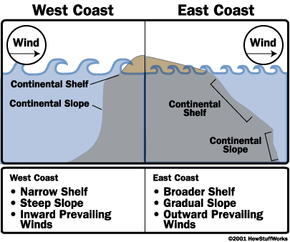Key Takeaways
- On the West Coast, prevailing winds push waves towards the coast, increasing their energy, while on the East Coast, winds tend to blow against the waves, reducing their size.
- The narrow continental shelf on the West Coast causes waves to rise abruptly and break closer to shore, whereas the broader shelf on the East Coast allows waves to break more gradually.
- The Pacific Ocean's larger fetch allows West Coast waves to travel farther and grow larger compared to the shorter fetch of the Atlantic Ocean affecting East Coast waves.
Some of the best surfing spots in the world are located along the U.S. West Coast and in Hawaii, and the reason is simple: the waves! But why are waves on the West Coast bigger than those on the East Coast? There are three primary factors that determine a wave's height:
- the prevailing winds
- the continental shelf
- the ocean fetch
According to the Encyclopedia of the Sea, a wave is "the oscillations of the sea caused by the wind blowing along the surface and moving in the direction in which the wind blows." One important thing to remember about waves is that the water isn't moving -- the energy from the wind is moving through the water (not to be confused with tides, which are more closely tied to the moon). On the West Coast, the prevailing winds are behind the waves, which increases the waves' energy. On the East Coast, the prevailing winds blow against the incoming waves, decreasing the waves' energy.
Advertisement
On each coast of the United States is a continental shelf. To understand the continental shelf, let's imagine that the ocean dried up. The land under the water looks a bit like the Grand Canyon, with cliffs and valleys, plateaus and ridges. On the West Coast, if you walked out onto the continental shelf, you would notice that the shelf (the area between the beach and where the drop-off begins) is narrower. This means that if you have less sand to walk on before the ocean's floor drops off steeply, like a cliff. On the East Coast, the shelf is broader -- there is more sand to walk on as the shelf drops gradually, like a really long ramp.
Underneath the surface of the water, particles are spinning in the direction that the wind is moving in. The particles are largest at the surface of the water. The deeper you go in the water, the smaller the spinning particles. As the wave moves inland and hits the upward slope of the continental shelf on the East Coast, the friction causes the particles to slow down, so the wave gradually collapses on itself. On the West Coast, the shelf rises suddenly near the coast, so the waves are much larger when they crash into the coastline -- the particles (and thus the wave) haven't been slowed down by extended friction with the shelf.
The Pacific Ocean on the West Coast has a greater expanse than the Atlantic Ocean on the East Coast. This means that the fetch (the distance over which the wind blows) is greater on the West Coast than on the East Coast. In this case, you can think of wave as a snowball: The farther you roll your snowball along in the snow, the bigger it gets. West-coast waves tend to start way out in the Pacific Ocean, so they have a greater distance to travel before they hit the shore -- more time to grow in size and length.
Dr. Ernie Knowles, associate professor of oceanography at NC State University, can help us put all of this together: "The steep shelf on the West Coast would cause a more abrupt buildup of the shoaling wave (so waves would be 'steeper' when they break). But the much longer fetch in the Pacific Ocean allows the waves to receive more wind energy, and so they grow larger. The swell arriving on the West Coast has periods in the range of 10 to 17 seconds (quite long waves), while the East Coast swell is more in the six- to 10-second range."
For more information on waves and related topics, try the links on the next page.
Advertisement
